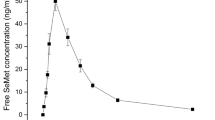Abstract
Determining the effect of selenium (Se) chemical form on uptake, transport, and glutathione peroxidase activity in human intestinal cells is critical to assess Se bioavailability at nutritional doses. In this study, we found that two sources of L-selenomethionine (SeMet) and Se-enriched yeast each increased intracellular Se content more effectively than selenite or methylselenocysteine (SeMSC) in the human intestinal Caco-2 cell model. Interestingly, SeMSC, SeMet, and digested Se-enriched yeast were transported at comparable efficacy from the apical to basolateral sides, each being about 3-fold that of selenite. In addition, these forms of Se, whether before or after traversing from apical side to basolateral side, did not change the potential to support glutathione peroxidase (GPx) activity. Although selenoprotein P has been postulated to be a key Se transport protein, its intracellular expression did not differ when selenite, SeMSC, SeMet, or digested Se-enriched yeast was added to serum-contained media. Taken together, our data show, for the first time, that the chemical form of Se at nutritional doses can affect the absorptive (apical to basolateral side) efficacy and retention of Se by intestinal cells; but that, these effects are not directly correlated to the potential to support GPx activity.





Similar content being viewed by others
Abbreviations
- GPx:
-
Glutathione peroxidase
- FBS:
-
Fetal bovine serum
- PBS:
-
Phosphate-buffered saline
- Se:
-
Selenium
- SeMSC:
-
Se-(methyl)selenocysteine
- SeMet:
-
L-selenomethionine
References
Combs GF Jr, Gray WP (1998) Chemopreventive agents: selenium. Pharmacol Ther 79:179–192
Finley JW (2006) Bioavailability of selenium from foods. Nutr Rev 64:146–151
Stadtman TC (1996) Selenocysteine. Annu Rev Biochem 65:83–100
Zeng H, Botnen JH (2007) Selenium is critical for cancer-signaling gene expression but not cell proliferation in human colon Caco-2 cells. Biofactors 31:155–164
Schrauzer GN (2001) Nutritional selenium supplements: product types, quality, and safety. J Am Coll Nutr 20:1–4
Zeng H (2009) Selenium as an essential micronutrient: roles in cell cycle and apoptosis. Molecules 14(3):1263–1278
Thomson CD, Robinson MF, Butler JA, Whanger PD (1993) Long-term supplementation with selenate and selenomethionine: selenium and glutathione peroxidase (EC 1.11.1.9) in blood components of New Zealand women. Br J Nutr 69:577–588
Bogye G, Alfthan G, Machay T (1998) Bioavailability of enteral yeast-selenium in preterm infants. Biol Trace Elem Res 65:143–151
Reeves PG, Briske-Anderson M, Newman SM Jr (1996) High zinc concentrations in culture media affect copper uptake and transport in differentiated human colon adenocarcinoma cells. J Nutr 126:1701–1712
Reeves PG, Briske-Anderson M, Johnson L (1998) Physiologic concentrations of zinc affect the kinetics of copper uptake and transport in the human intestinal cell model, Caco-2. J Nutr 128:1794–1801
Chen TR (1977) In situ detection of mycoplasma contamination in cell cultures by fluorescent hoechst 33258 stain. Exp Cell Res 104:255–262
Smith PK, Krohn RI, Hermanson GT et al (1985) Measurement of protein using bicinchoninic acid. Anal Biochem 150:76–85
Finley J, Matthys L, Schuler T, Korynta E (1996) Selenium content of foods purchased in North Dakota. Nutr Res 16:723–728
Zeng H, Botnen JH, Johnson LK (2008) A selenium-deficient Caco-2 cell model for assessing differential incorporation of chemical or food selenium into glutathione peroxidase. Biol Trace Elem Res 123:98–108
Zeng H, Wu M, Botnen JH (2009) Methylselenol, a selenium metabolite, induces cell cycle arrest in g1 phase and apoptosis via the extracellular-regulated kinase 1/2 pathway and other cancer signaling genes. J Nutr 139:1613–1618
Zeweibaum A, Chantret I (1989) Human colon carcinoma cell lines as in vitro models for the study of cell differentiation. In: Smith MW, Sepulveda FV (eds) Adaptation and development of gastrointestinal function. Manchester University Press, Manchester, UK, pp 103–112
Alvarez-Hernandez X, Smith M, Glass J (1994) Regulation of iron uptake and transport by transferrin in Caco-2 cells, an intestinal cell line. Biochim Biophys Acta 1192:215–222
Giuliano AR, Wood RJ (1991) Vitamin D-regulated calcium transport in Caco-2 cells: unique in vitro model. Am J Physiol 260:G207–G212
Leblondel G, Mauras Y, Cailleux A, Allain P (2001) Transport measurements across Caco-2 monolayers of different organic and inorganic selenium: influence of sulfur compounds. Biol Trace Elem Res 83:191–206
Clark LC, Combs GF Jr, Turnbull BW et al (1996) Effects of selenium supplementation for cancer prevention in patients with carcinoma of the skin. a randomized controlled trial. nutritional prevention of cancer study group. JAMA 276:1957–1963
Burk RF, Hill KE, Motley AK (2003) Selenoprotein metabolism and function: evidence for more than one function for selenoprotein P. J Nutr 133:1517S–1520S
Wilson DS, Tappel AL (1993) Binding of plasma selenoprotein P to cell membranes. J Inorg Biochem 51:707–714
Acknowledgments
We are grateful to Drs. Lazarova and Uthus for critical review of the manuscript. The technical support given by James Botnen, Craig Lacher, Bill Martin, Mary BriskeAnderson, Brenda Skinner, and LuAnn Johnson is greatly appreciated. This work was supported by the US Department of Agriculture.
Author information
Authors and Affiliations
Corresponding author
Additional information
The U.S. Department of Agriculture, Agricultural Research Service, Northern Plains Area, is an equal opportunity/affirmative action employer and all agency services are available without discrimination. The mention of a trademark or proprietary product does not constitute a guarantee or warranty of the product by the U.S. Department of Agriculture and does not imply its approval to the exclusion of other products that may also be suitable.
Rights and permissions
About this article
Cite this article
Zeng, H., Jackson, M.I., Cheng, WH. et al. Chemical Form of Selenium Affects Its Uptake, Transport, and Glutathione Peroxidase Activity in the Human Intestinal Caco-2 Cell Model. Biol Trace Elem Res 143, 1209–1218 (2011). https://doi.org/10.1007/s12011-010-8935-3
Received:
Accepted:
Published:
Issue Date:
DOI: https://doi.org/10.1007/s12011-010-8935-3




